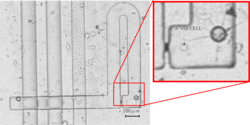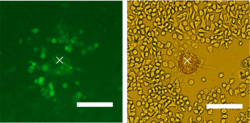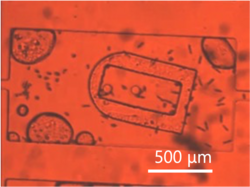
Nagai, Moeto
| Affiliation | Institute for Research on Next-generation Semiconductor and Sensing Science (IRES²) |
|---|---|
| Concurrent post | Department of Mechanical Engineering |
| Title | Professor |
| Fields of Research | BioMEMS, Biohybrid System, Micro-Nano Mechatronics, MicroTAS, Biofabrication, Micromachining |
| Degree | Ph.D. in Engineering from University of Tokyo |
| Academic Societies | The Japan Society Mechanical Engineering, The Japan Society for Precision Engineering, The Institute of Electrical Engineers of Japan |
| nagai@me Please append ".tut.ac.jp" to the end of the address above. |
|
| Laboratory website URL | https://hmn.me.tut.ac.jp/ |
| Researcher information URL(researchmap) | Researcher information |
Research
Our laboratory is working on scaling up work in the micro- and nano-domain. In particular, we conduct research and development for cell therapy and drug discovery, which require processing large volumes of single cells. We integrate the power of micro/nanodevices, mechatronics, and information science to achieve high-throughput cell processing treatment.
Theme1:Parallel Single Cell Manipulation
Overview
Single-cell analysis technology is a technology for detailed analysis of gene expression at the single-cell level and the mechanisms that regulate it at the DNA level. The high cost of single-cell analysis products is a major factor hindering the growth of the single-cell analysis market. As a lower cost and easier tool to handle single cells, nL pipette arrays will be developed using MEMS technology to investigate cell-cell interactions leading to cell therapy.
Selected publications and works
◆M. Nagai, K. Kato, S. Soga, T.S. Santra, and T. Shibata, Micromachines, Vol. 11(4), p. 442 (2020).
◆M. Nagai, K. Kato, K. Oohara, and T. Shibata, Micromachines Vol. 8(12), p. 350, (2017).
Keywords
Theme2:Optoporation and Single-cell screening
Overview
Modification of cells is required to induce cells to become the target cells. Here, laser light irradiation is used to selectively puncture cells and transport substances to modify their functions. This method is suitable for establishing cells for cell therapy, antibody-drug production, and disease models due to its ease of modifying conditions and minimally invasive nature.
The technique of screening cells from a cell population at the single-cell level is a fundamental technology in life science research. In this research, cells are maintained in an arrayed structure, and after observing cell dynamics, cells are classified using light irradiation. Cells removed from the microarray can be used to establish clonal lines or for further genetic analysis. This research will contribute to the promotion of cell therapy, antibody drugs, and disease models, and will enable the investigation of correlation analysis between single cells and gene expression.
Selected publications and works
◆Loganathan MOHAN, Ren HATTORI, Haipeng ZHANG , Yuki MATSUMURA, Tuhin Subhra SANTRA, Takayuki SHIBATA, Sangjin RYU, Moeto NAGAI, Surfaces and Interfaces, Volume 30, June 2022, 101820
◆L. Mohan, Srabani Kar, Ren Hattori, Miho Ishii-Teshima, Parthasarathi Bera, Sounak Roy, Tuhin Subhra Santra, Takayuki Shibata, Moeto Nagai, Applied Surface Science, Volume 543, 30 March 2021, 148815
Keywords
Theme3:Algae Cell Therapy
Overview
It is not easy to place a micro-object as desired. Algae have the ability to transport cargo simultaneously with photosynthesis. The combination leads to oxygen generation near an affected area and further transport drugs to help treat intractable diseases.
Selected publications and works
◆M Nagai, T Hirano, T Shibata, Micromachines, Vol. 10 (2), p. 130, (2019).
◆M. Nagai, K. Tanizaki, and T. Shibata, J. of Microelectromechanical Systems, Vol. 28, p. 419 (2019).
Keywords
Title of class
Mechanical Technology 2(B11530160), Mechanical Technology 2(B11530170), Experimental Practice for Mechanical Engineerings (B11610021, B11610023),Microsystems Engineering (M21621150)
Others (Awards, Committees, Board members)
Awards
MEXT 2018 Science and Technology Prize
2013 The Institute of Electrical Engineers of Japan (IEEJ), Sensors and Micromachines Society, Best Paper Award
2013 The Japan Society of Mechanical Engineers (JSME), Tokai Branch, Young Scientist Award
IEEE 2014 International Symposium on Micro-NanoMechatronics and Human Science (MHS 2014), Best Poster Award




